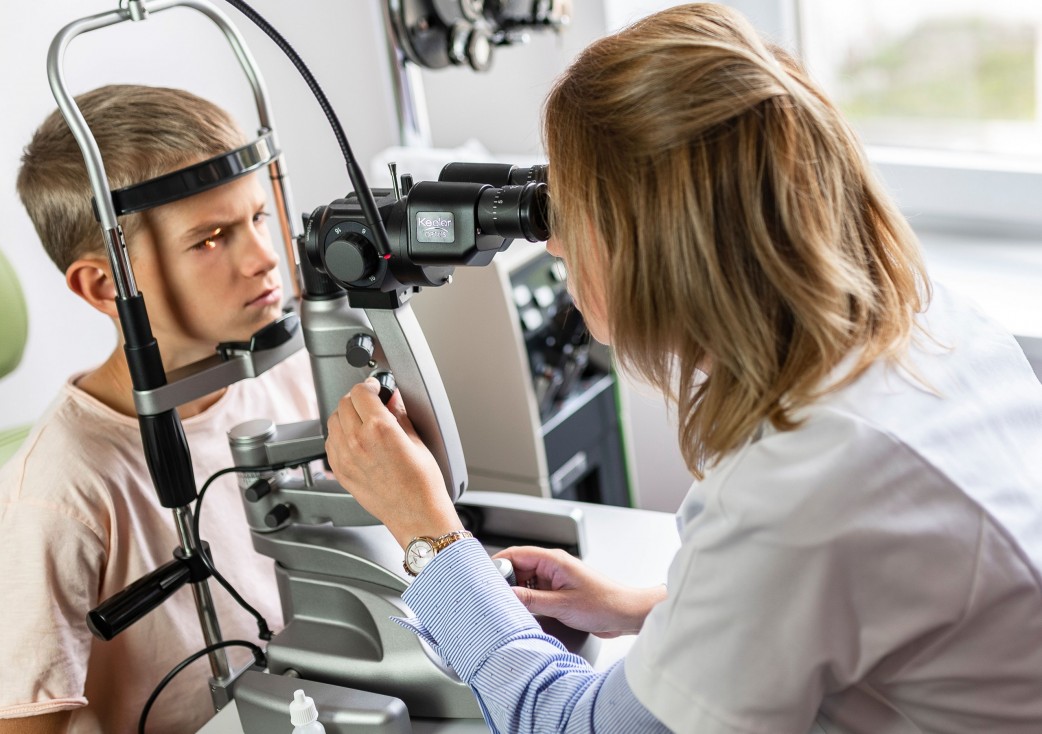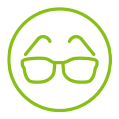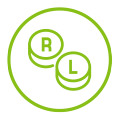To find out about the most suitable vision correction option, register for a visit, or find out other important information, leave your contacts, and we will contact you as soon as possible.
Vision and eye health of infants, children, adolescents and young people

Infant and baby up to 1 year of age
Generally, parents should plan the first visit to an ophthalmologist for children at the age of 1 year. Still, if the parents or paediatrician have any concerns about the child's vision or eye condition, any abnormalities such as persistent strabismus, purulent discharge from the eye, etc., are observed, they should visit immediately.
An ophthalmologist usually schedules the next visit. If all examinations are within the normal range, then an ophthalmologist is visited around the age of 3, then at the age of 5 or 6, and school age.
Opportunity for vision correction at this age - glasses.
Children from 1 to 7 years old
If during the child's visit to the ophthalmologist in the first year of life, the specialist has not found deviations from the norm of eye and vision development and has not determined a different visit plan. In that case, the next vision examination should be planned toward the age of 3.
If the baby has been prescribed optical correction - glasses, then the ophthalmologist should be visited sooner, as determined by a specialist during the last examination.
An annual examination of the child's eyes by a specialist ensures timely detection of the child's vision problems.
Children often do not complain about vision problems because they have nothing to compare. Young children may also not notice that one eye sees poorly, as the other eye can compensate for its poor eyesight.
There are several signs that parents may notice in time to detect that a child has vision problems:
- the child avoids proximity work;
- tends to tilt his head;
- closes one eye;
- blinks when looking into the distance or near;
- complains of frequent headaches, especially after work nearby;
- complains of blurred vision, doubling, etc.
Any complaints or suspicions about vision problems indicate an eye doctor's visit.
Children can see from birth, but the visual system fully develops by the age of 7-8.
Remember:
- If any changes prevent information from the eye to enter the central nervous system in the brain during this period, then the development of vision is delayed, or its development is incomplete. The earlier the disorder is detected, the greater the chances of developing full vision.
- If the child wears glasses, it is essential to monitor vision changes and the spectacle frame's adequacy. The child grows up, so the frame of the glasses, like clothes and shoes, can be too small.
Opportunity for vision correction at this age - glasses.
Children and adolescents
It is believed that by the age of 8, the child has developed a visual system.
Eye and visual examinations in adolescents should be performed as necessary and in cases where the child complains of eye discomfort, blurred vision or other acute issues.
If there are no special complaints, and the child does not need to use vision correction aids. If no eye diseases have been observed in the parents and immediate family members, a specialist's visit is recommended once a year or every two years.
IMPORTANT! Given the intense visual load on different types of screens, it is essential to keep an eye on eye rest, overall healthy eating, adequate physical activity and rest.
- If a child wears glasses, contact lenses, or night lenses, follow regular eye and vision tests prescribed by a specialist.
- If a teenager wears contact lenses or night lenses, parents should also pay attention to the proper fulfilment of hygiene conditions in the care of contact lenses and night lenses.
- It is necessary to remember about the spectacle frame - as the child grows, the spectacle frame must also be changed, because like clothes, the spectacle frame can become too small.
Possibilities of vision correction at this age - glasses, contact lenses or night lenses.
Adolescents and young people
It is essential for teenagers and young people to pay attention to the time spent on different types of screens. Extreme vision can cause dry eye syndrome, which can later be lifelong. Adequate rest of the eyes, overall healthy eating and physical activity, rest and fresh air play a significant role.
- If the young person's daily activities do not require visual aids - glasses or contact lenses, or night lenses and no severe eye diseases have been detected in the family, a preventive visit to the eye doctor is recommended once a year.
- In the case of eye and vision complaints or discomfort, a visit is required immediately.
- If a young person wears glasses, contact lenses or night lenses, it is important to follow an individually determined schedule of specialist visits and proper care of aids.
As laser vision correction can be performed from the age of 18, the schedule of post-procedure visits prescribed by a doctor must be strictly followed after the correction procedure.
Possibilities of vision correction at the age of 12 - 18:
glasses; contact lenses; night lenses.
Possibilities of vision correction from 18 years of age:






